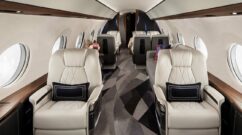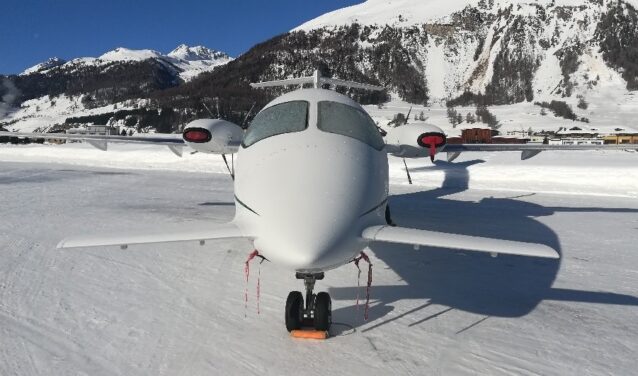PRIVATE JET DE-ICE:
Just like a vehicle sleeping outside in winter, a private jet subjected to harsh weather conditions will be covered with snow and ice.
But unlike a vehicle (car or truck), an aircraft must be completely cleared of snow and ice in order to take off for safety conditions. Ice on an aircraft will seriously affect the aircraft’s performance.
For more information on de-icing or winter flights, call 24 hours a day on +33 1 44 09 91 82.
Renting a private jet or helicopter is very simple. AEROAFFAIRES has a fleet of private aircraft and helicopters ready to take off H24. In order to book a flight, several solutions are available to you:
- make an online quote,
- or call us directly via our booking hotline at +33 1 44 09 91 82.
De-icing with AEROAFFAIRES
How to de-ice a private jet?
At the airport, the de-icing fluid is sprayed onto the fuselage of a private jet using a special truck called a de-icer. This can be an impressive operation for passengers because the orange liquid, glycol, is sprayed onto the aircraft using a hose that looks like a fire hose.
Passengers are usually on board the private jet during the de-icing operation so that the aircraft can take off very quickly as soon as the de-icing is completed.
Why is it necessary to carry out a de-icing operation on private jets?
The concept is simple: it is the removal of snow or ice from the private jet or aircraft so that it is not too heavy to take off and does not compromise safety. The operation concerns the wings but also the whole cabin.
How is de-icing carried out?
To de-ice an aircraft or a private jet, a product will be used on the entire aircraft and on its wings to melt snow and ice. It must not be acidic, so the aircraft is sprayed by mixing glycol and hot water. The time of de-icing will depend on the volume of snow accumulated on the private jet or aircraft. On average, about ten minutes is enough. Sometimes the snow is particularly heavy and sticky, so defrosting can take up to 30 minutes.
Defrosting is done with fixed defrosting stations and defrosting trucks. At Paris Le Bourget airport, there are 2 de-icing stations each equipped with four vehicles.
What glycol-based solutions are used to defrost private jets?
Two alcohols are required, ethylene glycol and propylene glycol, more or less dissolved with water, are used to defrost private jets at airports because they have melting temperatures below 0°C (-13°C for ethylene glycol, -59°C for propylene glycol). Their application reduces the freezing point of water on aircraft in the form of ice, ice or snow.
Ethylene glycol, frequently used as an antifreeze in automotive coolants, is toxic, so propylene glycol can be used by the food industry. Products containing at least 80% glycol, diluted or not, heated to over 60°C, can be used to remove any trace of snow, ice or frost on an aircraft. Preventive action (anti-icing) is also possible with thickened fluids based on 50% glycol, according to the General Directorate of Civil Aviation (DGAC).
How much does it cost to deice a private jet?
De-icing fluid has a very high cost. It depends on each airport that determines the rate per litre of liquid based on its sole supplier. You will find the average costs of liquid and de-icing operations, for each category of private jets and aircraft:
| Aircrafts Classifications | Liquid volume necessary per litre | Pricing per volume | Rate |
|
Turbopropellers |
40 | €5 | €200 |
|
Ultra-light private jets |
180 | €5 |
€900 |
|
Medium-sized private jets |
280 | €5 |
€1400 |
|
Long range private jets |
450 | €5 |
€2250 |
|
Regional aircrafts |
600 | €5 |
€3000 |
|
Commercial airliners |
1800 | €5 |
€9000 |
These prices may vary depending on the thickness of the icing and the aircraft.
If you wish to know the different rates at AEROAFFAIRES, contact us by e-mail or by phone at +33 (0)1 44 09 91 82
Payment for deicing a private jet?
It is up to the customer who rents a private jet to pay the de-icing fees when necessary. This cost is not included in the charter rate. If the captain decides that defrosting your aircraft is necessary on the day of the flight, you will receive an additional invoice following the flight with the amount at actual cost.
How can I protect myself from the costs of defrosting?
The captain of a private jet can avoid de-icing by placing their aircraft in a hangar or covered parking lot. However, in some airports, the prices of a hangar may be higher than the prices of a de-icing, particularly in Lapland or Switzerland. In addition, it often happens that airports intended only for private jets do not have space in their hangars, your private jet will have to remain outside despite the difficult weather conditions while waiting for takeoff. This is the case in Engadin Airport St. Moritz/Samedan.
An aircraft may also sleep outside but be de-iced in a heated hangar before takeoff. In general, one hour is sufficient to melt the snow or ice on the cabin and on the wings of the aircraft. This alternative is the most economical because it reduces defrosting costs, sometimes completely avoiding defrosting.
At some airports, passengers will board in the hangar. During the winter, AEROAFFAIRES recommends this option to its customers.
Some recommendations for deicing a private jet:
- One day before your departure, contact your air broker to ask him if de-icing will be necessary given the forecasted weather conditions. Even if in the mountains, the weather varies quickly, 24 hours is enough to give the general trend.
- Book a space in a hangar so that your private jet is not subject to weather conditions (snow, ice, cold…). A hangar with heating can also be the most economical solution because the aircraft will have to stay there for a good hour to allow the ice to melt before takeoff.
- Reduce your liquid intake by encouraging your crew to clear the aircraft’s wings with a brush before de-icing if it is a light private jet only. For safety reasons, the wings of a large jet should not be cleared of snow.
- Notify your captain of the time you will arrive at the boarding terminal, so that you do not de-ice a few minutes before your arrival and so that you do not have to do it a second time.
- Be on board the aircraft during de-icing so that you can take off immediately after the aircraft is sprayed with liquid. If a delay occurs, the private jet will have to be de-iced again.
- Never oppose defrosting. If your captain makes this decision, it is for safety reasons and not for financial interests.
- Before the operation, ask your captain what volume of liquid will be needed and in the case of a light private jet if it is possible to pass the brush through the crew on the fuselage to reduce the liquid bill.
- If you have the possibility between two airports, do not hesitate to ask about the price of de-icing fluid for each. Choose the one offering the lowest rate. In practice, the cost of de-icing is more expensive than take-off or landing and general service taxes.
- Place your appointments in the early afternoon when possible, defrosting takes place especially during very early morning departures before 10am. A few rays of sunlight are enough to make the snow and ice disappear on the fuselage of a private jet.
TOP questions about defrosting a private jet
Why does an aircraft have to be de-iced?
Before taking off from an airport, it is imperative that any ice or snow on an aircraft’s fuselage be completely removed for safety reasons.-Ice and snow will reduce the lift of an aircraft’s wings.
Even a thin layer of ice can reduce an aircraft’s flight performance.
-These elements are heavy and this additional weight will hinder the performance of the aircraft and therefore the flight conditions.
-In addition, ice can prevent the proper operation of a private jet, such as ailerons, landing gear or control surfaces can be blocked by ice.
What product is used for defrosting?
A heated liquid will be propelled on the fuselage of the aircraft and its wings to melt ice and snow and will also form an antifreeze device during the period called “duration of effectiveness”.
Do we find “de-icer” and de-icing fluid in all airports?
In 2010, Roissy experienced a deicing fluid rupture forcing ADP (Paris Airport to collect liquid, Glycol, in the United States. In addition, many aerodromes do not have any de-icing equipment. On the other hand, at mid-sized airports, you will find cash but it may take time and create a delay in take-off but safety is paramount.
What are the best places to defrost a private jet?
The answer will seem classic to you, it is Scandinavia, Germany and the United States, which have well-established defrosting processes.
Is the de-icing fluid dangerous to health?
It is a dangerous chemical product, particularly for the skin. A passenger on a private jet should not approach or touch the de-icing fluid even if its almond smell is pleasant.






